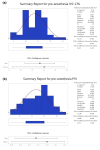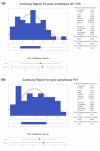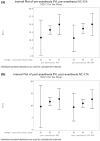Correlation between pleth variability index and ultrasonic inferior vena cava-collapsibility index in parturients with twin pregnancies undergoing cesarean section under spinal anesthesia
- PMID: 35933431
- PMCID: PMC9356457
- DOI: 10.1186/s40001-022-00771-3
Correlation between pleth variability index and ultrasonic inferior vena cava-collapsibility index in parturients with twin pregnancies undergoing cesarean section under spinal anesthesia
Abstract
Background: To explore the correlation and consistency of non-invasive pleth variability index (PVI) combined with ultrasonic measurement of inferior vena cava-collapsibility index (IVC-CI) in parturients with twin pregnancies undergoing cesarean section under spinal anesthesia.
Methods: Forty-seven twin pregnancies women undergoing elective cesarean section were selected. The ASA score was rated as I-II, aged from 18 to 45 years. Spinal anesthesia was performed at L3-4. PVI and IVC-CI, general data (BMI, gestational weeks, operation duration, blood loss), MAP, temperature sensory block level and adverse reactions were recorded at baseline (T1) and completion of testing the level of spinal anesthesia (T2).
Results: The correlation coefficient analysis of baseline IVC-CI% and PVI revealed that the Pearson's coefficient was 0.927, > 0.4. Thus, pre-anesthesia IVC-CI% had a strong correlation with PVI, with R2 of 85.69%. The correlation coefficient analysis of post-anesthesia IVC-CI% and PVI revealed that the Pearson's coefficient was 0.904, > 0.4. Thus, post-anesthesia IVC-CI% had a strong correlation with PVI, with R2 of 81.26%.
Conclusion: PVI is strongly consistent with ultrasound measurement of IVC-CI twin pregnancies, which can be used as a valuable index for predicting the volume in parturients with twin pregnancies undergoing cesarean section under spinal anesthesia. Trial registration This study was registered on ClinicalTrials.gov with clinical trial registration number of ChiCTR2200055364 (08/01/2022).
Keywords: Inferior vena cava-collapsibility index; Pleth variability index; Spinal anesthesia; Twin pregnancies.
© 2022. The Author(s).
Conflict of interest statement
The authors declare that they have no competing interests.
Figures







Similar articles
-
Role of pleth variability index for predicting hypotension after spinal anesthesia for cesarean section.Int J Obstet Anesth. 2014 Nov;23(4):324-9. doi: 10.1016/j.ijoa.2014.05.011. Epub 2014 Jun 10. Int J Obstet Anesth. 2014. PMID: 25262278
-
Volume status evaluation by IVC diameter and pleth variability index in spinal anesthesia.Cir Cir. 2024 Nov 20;93(1):68-75. doi: 10.24875/CIRU.23000090. Cir Cir. 2024. PMID: 39566108
-
Ultrasound evaluation of inferior vena cava compression in tilted and supine term parturients.Can J Anaesth. 2021 Oct;68(10):1507-1513. doi: 10.1007/s12630-021-02051-w. Epub 2021 Jul 1. Can J Anaesth. 2021. PMID: 34212308 English.
-
Ability of pulse oximetry-derived indices to predict hypotension after spinal anesthesia for cesarean delivery: A systematic review and meta-analysis.PLoS One. 2025 Jan 31;20(1):e0316715. doi: 10.1371/journal.pone.0316715. eCollection 2025. PLoS One. 2025. PMID: 39888882 Free PMC article.
-
Inferior Vena Cava Collapsibility Index: Clinical Validation and Application for Assessment of Relative Intravascular Volume.Adv Chronic Kidney Dis. 2021 May;28(3):218-226. doi: 10.1053/j.ackd.2021.02.003. Adv Chronic Kidney Dis. 2021. PMID: 34906306 Review.
Cited by
-
Effect of carotid corrected flow time combined with perioperative fluid therapy on preventing hypotension after general anesthesia induction in elderly patients: a prospective cohort study.Int J Surg. 2024 Feb 1;110(2):799-809. doi: 10.1097/JS9.0000000000000863. Int J Surg. 2024. PMID: 37983823 Free PMC article.
-
Comparative dose-response study of intrathecal hyperbaric ropivacaine for cesarean delivery in preterm singleton versus twin pregnancies.Reg Anesth Pain Med. 2024 Oct 8;49(10):764-769. doi: 10.1136/rapm-2023-104875. Reg Anesth Pain Med. 2024. PMID: 37903623 Free PMC article. Clinical Trial.
-
Evaluation of extravascular lung water and cardiac function in normal vaginal delivery by intrapartum bedside ultrasound.BMC Pregnancy Childbirth. 2024 Jan 2;24(1):13. doi: 10.1186/s12884-023-06201-4. BMC Pregnancy Childbirth. 2024. PMID: 38166871 Free PMC article.
References
-
- Coeckelenbergh S, Delaporte A, Ghoundiwal D, Bidgoli J, Fils JF, Schmartz D, Van der Linden P. Pleth variability index versus pulse pressure variation for intraoperative goal-directed fluid therapy in patients undergoing low-to-moderate risk abdominal surgery: a randomized controlled trial. BMC Anesthesiol. 2019;19(1):34. doi: 10.1186/s12871-019-0707-9. - DOI - PMC - PubMed
MeSH terms
Grants and funding
LinkOut - more resources
Full Text Sources
Medical

